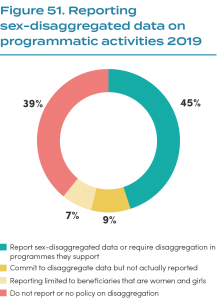Sex-disaggregated monitoring and evaluation data: walking the talk on evidence?
Gender data, often described as data disaggregated by sex and analysed to understand the differential service access or health outcomes for women, men, girls, and boys, is pivotal to exposing and understanding gender-based inequities in health and development. Yet organisations generally fail to even present sex-disaggregated programmatic data.
Fewer than half (86/196) of organisations disaggregate their programme data by sex, and a further 7% (14/196) report the proportion of beneficiaries who are women and girls. The proportion of organisations that do not report sex-disaggregated data has fallen from 53% in 2018 to 39% in 2019.
Around one in 10 organisations appear to support the idea of sex-disaggregated data and analysis, but do not present this data on their websites or in their flagship reports—a number unchanged since 2018.



